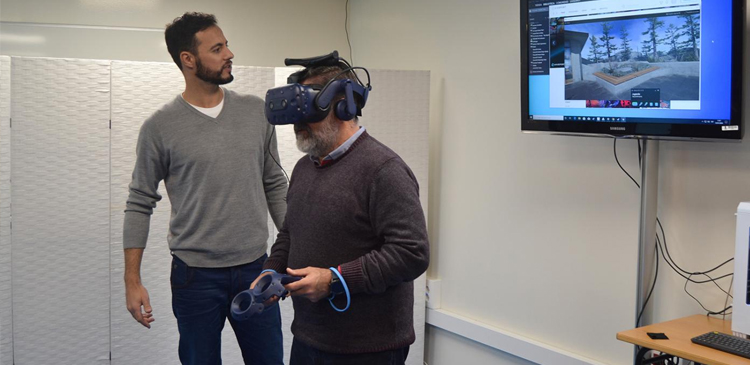Evaluating the possibilities of total or immersive virtual reality to design and develop therapeutic physical activity programmes for senior citizens is the central objective of a pioneering area of research by the HealthyFit group, from the Faculty of Education and Sports Science. It takes as a starting point the hypothesis that this type of support can be attractive to generate greater adherence to physical activity and the possibilities represented when developing more personalised therapies, a first pilot study among patients with Parkinson’s, within the framework of the doctoral thesis developed by Pablo Campo under the direction of the group’s main researcher, José María Cancela, and the professor of the Faculty of Physiotherapy, Gustavo Rodríguez.
“What we want to see at first is the effect of different proposals for therapeutic intervention with virtual reality in a population with different pathological profiles,» explains Cancela, who points out that the therapeutic applications of immersive virtual reality have so far only been studied to address problems «of a psychological nature, but not for physical therapy». To develop this area of research, the HealthyFit group acquired a head-mounted display, with which it will first seek to analyse the possible application of some of the thousands of existing experiences and games for this type of device as ways to prescribe a physical activity which is adapted to the characteristics of each user. The objective, Cancela adds, is to take advantage of the “adhesion capacity» of the games to «work unconsciously on certain parameters that would otherwise be much more complicated.» Not surprisingly, this type of platform would allow activities to be carried out in a «safe environment» in which the elderly have to «respond to a series of stimuli», while making it possible to design individualised therapies, since the programme itself would allow for real-time evaluation of the parameters. «It would effectively be intervention and evaluation at the same time, which allows us to adapt the therapy based on the results achieved in the previous sessions,» says Cancela.
A programme adaptable to each person and pathology
“This is also a way of showing that therapeutic exercise programmes can be performed through technology», adds the physiotherapist Pablo Campo, who focuses the research for his thesis on the design and development of a therapeutic programme based on the use of this technology. Until now, it has carried out some initial “pilot tests” with the aim of “observing the motivation generated by the system”, while confirming that it is a safe activity for senior citizens. «The tests are being tremendously positive,» acknowledges Campo, who also worked on the adaptation into Spanish of a scale that would allow the identification of «the main symptoms associated with immersion» – a device in which users can see themselves in the middle of multiple virtual stages. After this initial analysis, his next objective is to develop with senior citizens “a programme of therapeutic exercise, which can be adapted to the characteristics of the people, such as age, pathologies, symptoms or, for example, to the pharmacology associated with them», and which will facilitate working from aspects of improving coordination, balance, reflexes or joint mobility to specific issues related to certain pathologies, such as gait disturbances in Parkinson’s patients.
A long-term line of work
As Cancela points out, this pilot study constitutes the starting point of a “long-term” line of work for the HealthyFit group, who recently signed collaboration agreements with two companies specialising in virtual reality and software development. «Immersive virtual reality was born as a game, and there are countless games that, with just a small modification, can be used as therapy for these groups», highlights the researcher. In this way, in a first phase, the research will focus on evaluating which games and programmes already in existence «are more suited to a certain pathology, due to their characteristics», and then «adapt them as therapies». With the collaboration of the companies, the group will also seek to be able to design «therapeutic intervention proposals» based on virtual reality, with the final purpose of «trying to create an online therapeutic platform» with the resources developed.
The first test, with Parkinson’s patients
With the collaboration of the Parkinson’s Association of Vigo, in recent weeks Campo was able to carry out a pilot study with people affected by this disease. “We looked for a game profile that was easy to interpret, with the idea of stimulating patients with a type of therapeutic exercise that would be attractive to them and that would trigger their attention mechanisms,» says Campo. These tests sought to verify whether the proposal was «attractive, feasible and safe», also taking into account the potential of virtual reality in the treatment of a pathology in which physical exercise programmes produce greater effects when they add «cognitive strategies such as attracting attention, which implies the execution of tasks with focused attention to adapt responses to the stimuli presented”, as in this case those proposed through a virtual environment would be.
Among the first to test this proposal were members of the association including Daniel Rodríguez, 89, who recognises that the physical activity he performed through games included «many of the movements we perform in physiotherapy»; and Salvador Rey, 68, who highlighted the advantage of being able to perform a personalised activity. After testing the device, the 61-year-old, also a member of the Moises Ogando association, also praised the appeal of using a game “that allows, in virtual reality, but a totally controlled manner, to develop activities that help us in aspects that we have damaged, such as coordination”.

